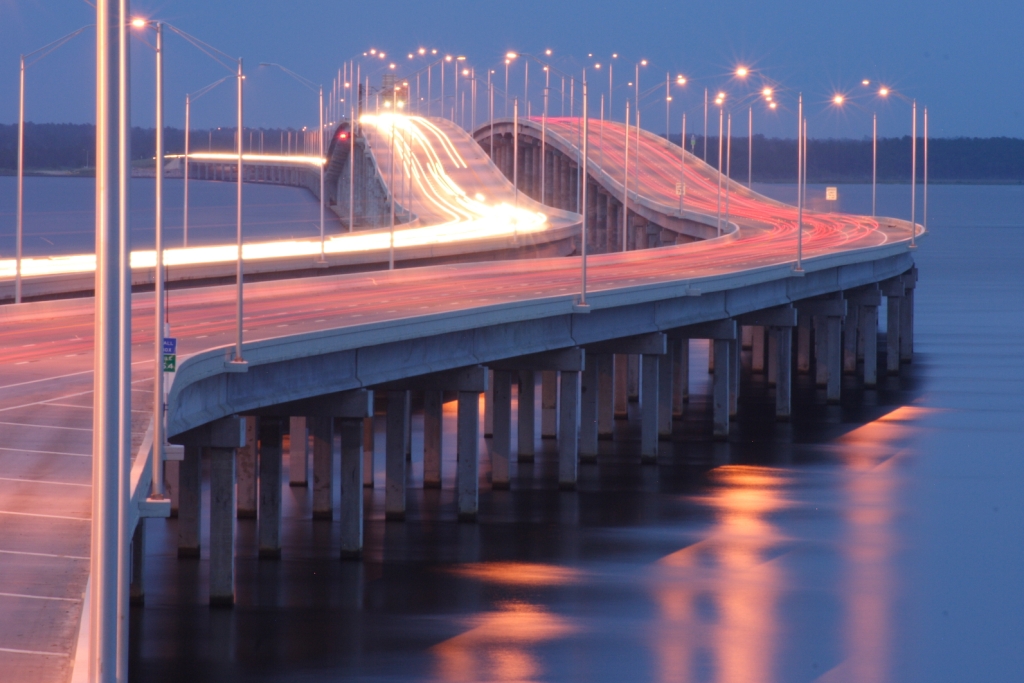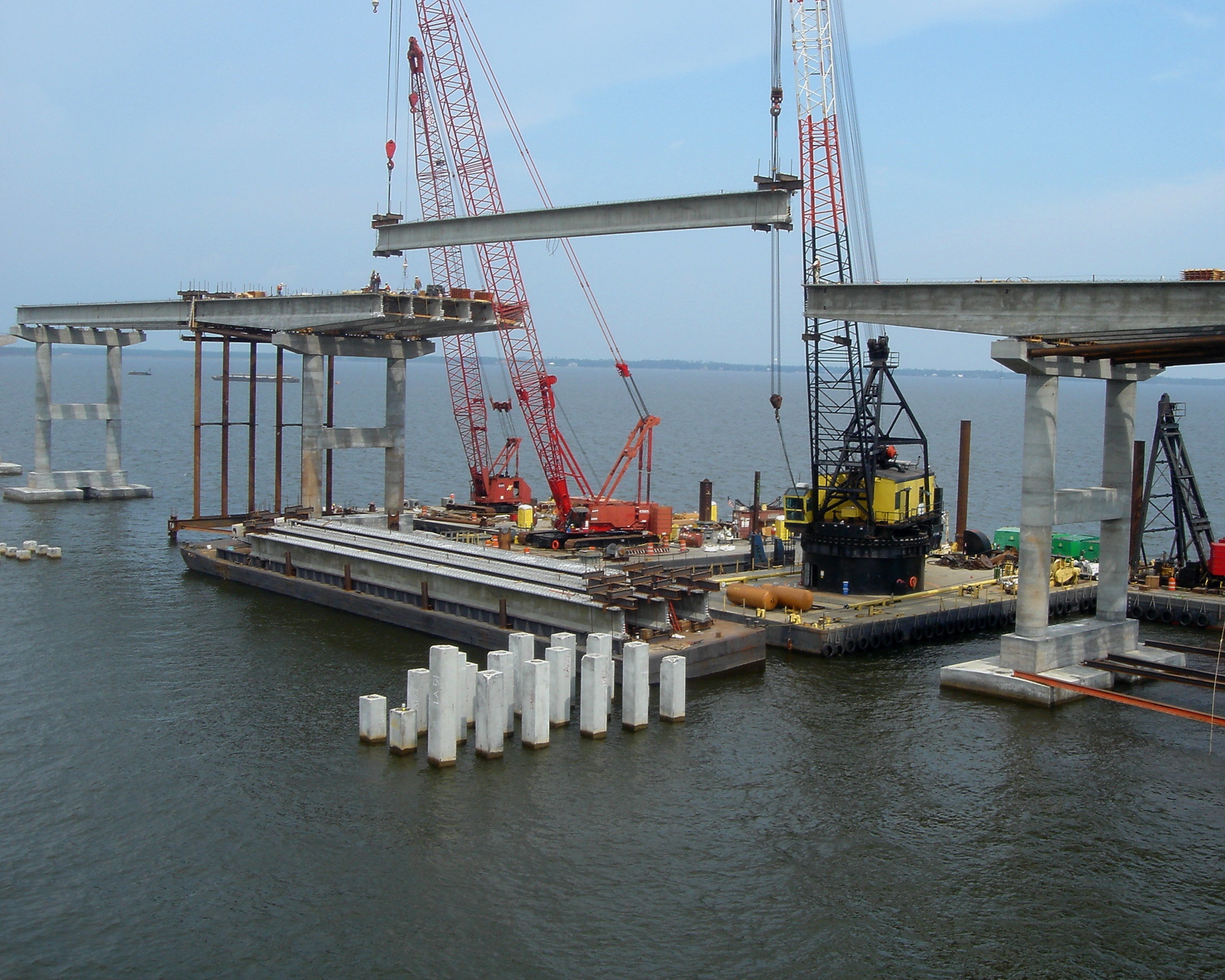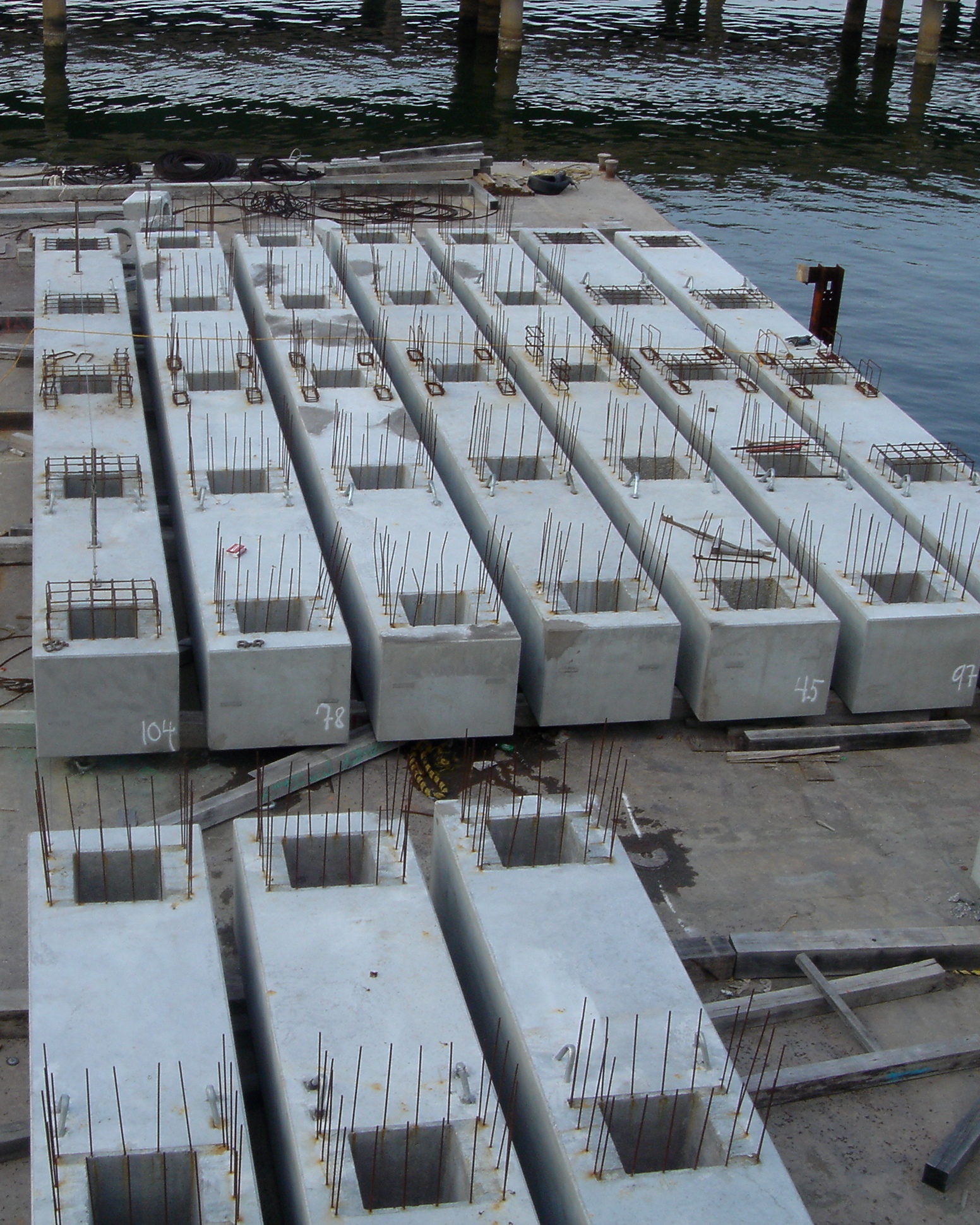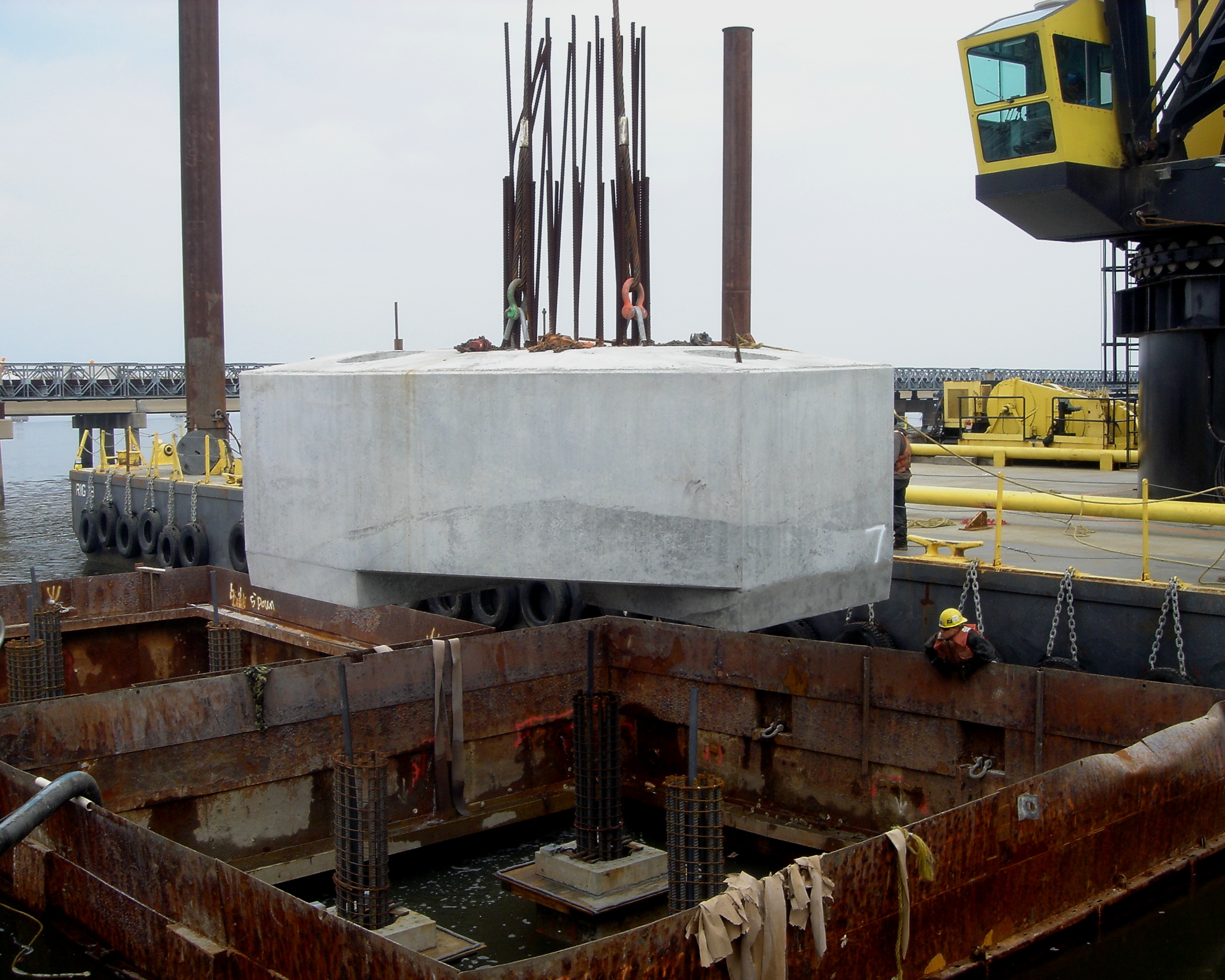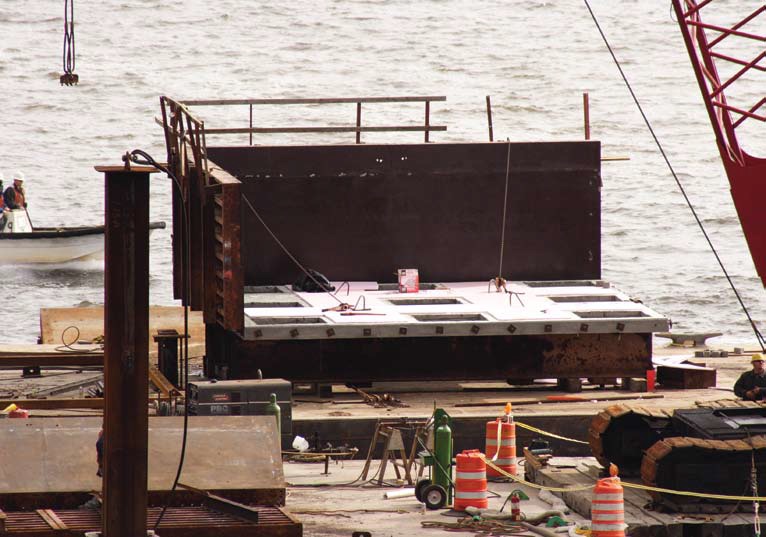State: FL
County: between Escambia and Santa Rosa Counties
Owner: State
Location: Rural
Spans: > Three-span
Beam material: Concrete
Max Span Length (ft.): 250
Total Bridge Length (ft.): 13728
Construction Equipment Category: Other ABC Method
ABC Construction Equipment: high-capacity crane on barge
State ID Number: 480213 (EB) / 480214 (WB)
NBI Number: 480213 (EB) / 480214 (WB)
Coordinates
Latitude: 30.517778 | Longitude: -87.145556
Bridge Description
Project Summary:Precast pile caps and precast footings were placed with high-capacity cranes on barges to speed construction.
Project Location:
Interstate 10 over Escambia Bay in northwestern Florida
Impact Category:
Tier 6 (longer but reduced by months/years)
Mobility Impact Time:
- ABC: Twin bridges completed in 2 years and 8 months
- Conventional: Additional year
Primary Drivers:
- reduced onsite construction time – I-10 is the only east-west interstate in the southern region of the US
- reduced traffic impacts – the existing I-10 eastbound bridge could only carry one lane of interstate traffic, creating significant delay and interstate traffic backups
- improved work-zone safety
- improved site constructability – eliminated time-consuming cast-in-place construction on the water; also allowed the contractor to use two precasters
- improved material quality and product durability
Dimensions:
2.6-mile-long and 59-ft-wide 102-span twin bridges, each with pretensioned concrete bulb-tee girder spans (60-ft to 138-ft-long span range typical) at piers and pile bents; with 616-ft-long 3-span spliced post-tensioned haunched girder unit (200 ft-250 ft-166 ft)
Average Daily Traffic (at time of construction):
21750
Traffic Management (if constructed conventionally):
extended use of 130-mile detour
Existing Bridge Description:
The existing bridge consisted of twin structures, each with two 12-ft-wide traffic lanes and 6-ft-wide shoulders. Built in 1968, the bridge was typically only 12 ft above mean tide level. It was heavily damaged during Hurricane Ivan in 2004. The bridge was temporarily repaired to maintain a total of two lanes of traffic pending construction of the replacement bridge.
Replacement or New Bridge:
The replacement bridge is aligned to the south of the existing bridge and is curved near the beginning and end of each approach. It was built higher than the original bridge to better resist storm surges. Its height above mean tide level ranges from 25 ft for typical spans to 65 ft over the navigation channel. The bridge has a total of six 12-ft traffic lanes (three eastbound and three westbound) and 10-ft inside and outside shoulders. The cross-section of all but the main span unit consists of five 6.5-ft-deep bulb-tee girders spaced at 12.5 ft, with an 8.5-inch-thick cast-in-place 5,500-psi reinforced concrete deck. Precast trestle pile caps were used for low-level piers, and precast waterline footings were used for high-level piers.
Construction Method:
To make efficient use of the high-capacity cranes on barges, the precast piles, pile caps, footings, and girders were approximately the same weight, with a maximum of 80 tons each. Most of the substructures consisted of a precast pile cap supported directly on five piles. These piles were 3-ft-square with a 22.5-inch-diameter void except for the 4-ft-long solid section at the bottom tip. The pile cap-to-pile connection was made by inserting a reinforcement cage into the top 10 ft of the pile in the length above the pile plug and into the pile cap pocket, and filling the pile void and cap pocket with concrete.
The other typical substructure type was piers with waterline footings. These footings became larger as they approached the navigation channel. For most of these piers, two precast footings each rested on three piles. The footings had pockets to accept the pile reinforcement cages, and had reinforcement extending from the top surface for connection to the cast-in-place pier columns. Movable cofferdams were used to install the precast footings below sea level. The cap pockets were filled with concrete.
The contract included A+B bidding and a $10 million bonus for early completion, as well as a $133,000 per day disincentive. Lane rental days were included to minimize inconvenience to the traveling public. Also included was a 5-year warranty for deck expansion joints, coatings, bearings, lighting and electrical systems, and drainage systems. FHWA designated the project as a Type 2 Categorical Exclusion.
The joint venture received the $10 million bonus when the new eastbound bridge opened 11 days early in December 2006. The width of the eastbound bridge allowed it to temporarily carry four 12-ft-wide traffic lanes, two in each direction, separated by a median barrier. Less than a year later the new westbound bridge was opened to traffic.
Stakeholder Feedback:
High Performance Material:
Project Planning
Decision Making Tools:Site Procurement: early environmental clearance & permitting
Project Delivery: design-build
Contracting: A+B bidding, warranty, lane rental, incentive / disincentive clause
Geotechnical Solutions
Foundations & Walls:Rapid Embankment:
Structural Solutions
Prefabricated Bridge Elements: precast pile cap, precast footing(s)Prefabricated Bridge Systems:
Miscellaneous Prefabricated: pocket connection (in precast substructure)
Costs & Funding
Costs:The low bid was $243 million. There were three shortlisted bidders.
ABC techniques saved an estimated $48.5 million ($133,000 x 365 days) in delay-related user costs.
Funding Source:
Federal and State
Incentive Program:
Additional Information
Downloadable Resources
Contract Plans: View I-10_Over_Escambia_Bay_Replacement_Plan_PartialDetails.pdf
Bid Tabs:
Construction Schedule:
Other Related Information:
Summer 2008 ASPIRE, The Concrete Bridge Magazine, “Innovative Solutions for Rapid Construction”
Other Related URLs:
Florida Department of Transportation
Contacts
Owner:
Robert V. Robertson, Jr., P.E.
State Structures Design Engineer
Florida Department of Transportation
Robert.Robertson2@dot.state.fl.us
850-414-4267




